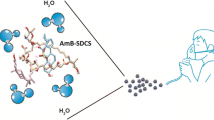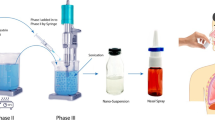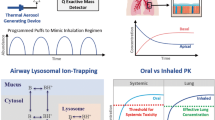Abstract
Systemically administered interferons are rapidly cleared from the circulation thus requiring frequent dosing to maintain the therapeutic levels of circulating interferon. This is particularly problematic for their use in the treatment of chronic diseases. The purpose of this study was to evaluate the potential of proprietary calcium phosphate (CaP) particles to deliver biologically active interferon alpha (IFNα) via the lungs into systemic circulation. Recombinant human IFNα-2a was formulated with proprietary CaP particles. In vitro biological activity of IFNα was assessed for its potential to activate IFN-induced cellular pathways in HEK-Blu-IFN α/β cell cultures. Antiviral activity was evaluated against vesicular stomatitis virus (VSV) infection of HeLa cells. Male BALB/c mice were used to evaluate the absorption of IFNα from CaP-IFNα across the lungs following intratracheal (IT) instillation. Serum IFNα concentrations up to 9 h post-treatment were determined. Data were analyzed to obtain pharmacokinetic (PK) parameters. Data from these studies indicated that IFNα formulated with CaP retains its biological activity, and it is transported into circulation in a dose-dependent manner. PK analysis showed larger than two-fold area under the serum concentration-time curve (AUC) for CaP-IFNα compared to non-formulated IFNα administered IT. The IFNα formulated with CaP had two-fold longer half-life (t1/2) and mean residence time (MRT) relative to IFNα alone administered by injection. Clearance of CaP-IFNα was slower than IFNα administered IM or IT. Relative bioavailability of CaP-IFNα was 1.3-fold of IFNα injection and twofold of IFNα administered IT. Furthermore, inhalation of aerosolized CaP did not indicate any lung toxicity in animals.






Similar content being viewed by others
References
Kadowaki N, Antonenko S, Lau JY, Liu YJ. Natural interferon alpha/beta-producing cells link innate and adaptive immunity. J Exp Med. 2000;192:219–26.
Schroder K, Hertzog PJ, Ravasi T, Hume DA. Interferon-gamma: an overview of signals, mechanisms and functions. J Leukoc Biol. 2004;75:163–89.
Huber CH, Wӧlfel T. Immunotherapy of cancer: from vision to standard clinical practice. J Cancer Res Clin Oncol. 2004;130:367–74.
Kirkwood JM, Richards T, Zarour HM, et al. Immunomodulatory effects of high-and low-dose IFNa2b in patients with high-risk resected melanoma: the E2690 laboratory corollary of intergroup adjuvant trial E1690. Cancer. 2002;95:1101–12.
Hanada T, Yoshimura A. Regulation of cytokine signaling and inflammation. Cytokine Growth Factor Rev. 2002;13:413–21.
Kontsek P, Karayianni-Vasconcelos G, Kontseková E. The human interferon system: characterization and classification after discovery of novel members. Acta Virol. 2003;47:201–15.
Debs RJ, Fuchs HJ, Philip R, Montgomery AB, Brunette EN, et al. Lung-specific delivery of cytokines induces sustained pulmonary and systemic immunomodulation in rats. J Immunol. 1988;140:3482–8.
Jonasch E, Haluska FG. Interferon in oncological practice: review of interferon biology, clinical applications, and toxicities. Oncologist. 2001;6:34–55.
Gresser I, Belardelli F. Endogenous type I interferons as a defense against tumors. Cytokine Growth Factor Rev. 2002;13:111–8.
Cooksley WGE. The role of interferon therapy in hepatitis B. MedGenMed. 2004;6:16. Published online
Manesis EK, Hadziyannis J. Interferon alpha treatment and retreatment of hepatitis B antigen-negative chronic hepatitis B. Gastroenterology. 2001;121:101–9.
Manns MP, Wedemeyer H, Cornberg M. Treating viral hepatitis C: efficacy, side effects, and complications. Gut. 2006;55:1350–9.
Yu ML, Hou NJ, Dai CY, Chang WY, Chuang WL. Successful treatment of fulminant hepatitis C by therapy with alpha interferon and ribavirin. Antimicrob Agents Chemother. 2005;49:3986–7.
Goldstein D, Laszlo J. The role of interferon in cancer therapy: a current perspective. Cancer J Clin. 1988;38:258–77.
Matsumoto K, Okano J, Murawaki Y. Differential effects of interferon alpha-2b and beta on the signaling pathways in human liver cancer cells. J Gastroenterol. 2005;40:722–32.
Ferrantini M, Belardelli F. Gene therapy of cancer with interferon: lessons from tumor models and perspectives for clinical applications. Semin Cancer Biol. 2000;10:145–57.
Kubo S, Nishiguchi S, Hirohashi K, Tanaka H, Shuto T, Yamazaki O, et al. Effects of long-term postoperative interferon-therapy on intrahepatic recurrence after resection of hepatitis C virus–related hepatocellular carcinoma: a randomized, controlled trial. Ann Intern Med. 2001;134:963–7.
Someya T, Ikeda K, Saitoh S, Kobayashi M, Hosaka T, et al. Interferon lowers tumor recurrence rate after surgical resection or ablation of hepatocellular carcinoma: a pilot study of patients with hepatitis B virus-related cirrhosis. J Gastroenterol. 2006;41:1206–13.
Shepherd FA, Evans WK, Garvey B, Read SE, Klein M, et al. Combination chemotherapy and alpha-interferon in the treatment of Kaposi’s sarcoma associated with acquired immune deficiency syndrome. Canadian Med Assoc J. 1988;139:635–9.
Schreiner B, Mitsdoerffer M, Kieseier BC, Chen L, Hartung HP, et al. Interferon-beta enhances monocyte and dendritic cell expression of B7-H1 (PD-L1), a strong inhibitor of autologous T-cell activation: relevance for the immune modulatory effect in multiple sclerosis. J Neuroimmunol. 2004;155:172–82.
Physicians’ Desk Reference,2004. 58th edition Thomson PDR, Montvale.
Thipphawong J. Inhaled cytokines and cytokine antagonists. Adv Drug Deliv Rev. 2006;58:1089–105.
Luessen HL, Tytonis BV, Borchard G 2010. Protein pharmaceuticals: recent achievements and trends for formulation and delivery. In: OnDrugDelivery, Injectable Drug Delivery : Formulations Focus: page 4–7. Can be accessed http://ondrugdelivery.com/publications/Injectable%20Formulations%202010/Injectable_Drug_Delivery_2010_Formulations_Focus.pdf
Hamidi M, Zarrin A, Foroozesh M. Novel delivery systems for interferons. Crit Rev Biotechnol. 2007;27:111–27.
Kuzmov A, Tamara MT. Nanotechnology approaches for inhalation treatment of lung diseases. J Control Release. 2015;219:500–18.
Agu RU, Ugwoke MI, Armand M, Kinget R, Verbeke N. The lung as a route for systemic delivery of therapeutic proteins and peptides. Respir Res. 2001;2:198–209.
Hickey AJ. Back to the future: inhaled drug products. J Pharm Sci. 2013;102:1165–72.
Ruge CA, Kirch J, Lehr CM. Pulmonary drug delivery: from generating aerosols to overcoming biological barriers? Therapeutic possibilities and technological challenges. Lancet Respir Med. 2013;1:402–13.
Giosuè S, Casarini M, Ameglio F, Alemanno L, Saltini C, Bisetti A. Minimal dose of aerosolized interferon-α in human subjects: biological consequences and side-effects. Eur Respir J. 1996;9:42–6.
Bocci V. Evaluation of routes of administration of interferon in cancer: a review and proposal. Cancer Drug Deliv. 1984;1:337–40.
Bocci V. In: Baron S, Coppenhaver DH, Dianzani F, et al., editors. Pharmacokinetics of interferons and routes of administration. Interferon. Principles and medical application. Houston, Texas: UTMB Press; 1992. p. 417–25.
Lombry C, Edwards DA, Preat V, Vanbever R. Alveolar macrophages are a primary barrier to pulmonary absorption of macromolecules. Am J Physiol Lung Cell Mol Physiol. 2004;286:L1002–8.
Yamamoto A, Okumura S, Fukuda Y, Fukui M, Takahashi K, Muranishi S. Improvement of the pulmonary absorption of (Asu1,7)-eel calcitonin by various absorption enhancers and their pulmonary toxicity in rats. J Pharm Sci. 1997;86:1144–7.
Yamamoto A, Iseki T, Ochi-Sugiyama M, Okada N, Fujita T, Muranishi S. Improvement of the pulmonary absorption of eel calcitonin from various mucosal administration sites. J Control Release. 2001;76:363–74.
Hickey AJ, Garcia-Contreras L. Immunological and toxicological implications of short-term studies in animals of pharmaceutical aerosol delivery to the lungs: relevance to humans. Crit Rev Ther Drug Carrier Syst. 2001;18:387–431.
Heinemann L, Klappoth W, Rave K, Hompesch B, Linkeschowa R, Heise T. Intra-individual variability of the metabolic effect of inhaled insulin together with an absorption enhancer. Diabetes Care. 2000;23:1343–7.
Mueller R. Solid lipid nanoparticles (SLN) for controlled drug delivery-a review of the state of the art. Eur J Pharm Biopharm. 2000;50:161–77.
Mueller R. Lipid nanoparticles: recent advances. Adv Drug Deliv Rev. 2007;59:375–6.
Ugwoke MI, Vereyken IJ, Luessen H. Microparticles and liposomes as pulmonary drug delivery systems: what are the recent trends? Trends and Opportunities, Chapter VI, pp. 308–311.
Paranjpe M, Müller-Goymann CC. Nanoparticle-mediated pulmonary drug delivery: a review. Int J Mol Sci. 2014;15:5852–73.
Garcia-Contreras L, Morçӧl T, Bell SJD, Hickey AJ. Evaluation of novel particles as pulmonary delivery systems for insulin in rats. AAPS PharmSci. 2003;5:10–20.
Garcia-Contreras L, Morçӧl T, Bell SJD, Hickey AJ. Evaluation of novel calcium phosphate particles as pulmonary delivery systems for insulin in rats. AAPS PharmSci (Suppl). 2001;3(3)
Bell SJD, Morçӧl T, He Q. Therapeutic calcium phosphate particles and methods of manufacture and use. US Patent 6,355,271 (2002).
Bell SJD, Morçӧl T, He Q. Therapeutic calcium phosphate particles and methods of manufacture and use. US Patent 8,431,221 (2013).
Morçӧl T, Nagappan P, Nerenbaum L, Mitchel AR, Bell SJD. Particulate drug delivery systems for protein drugs. In: Kumar R, editor. Particlute Drug Delivery, vol. 2. Stevenson Ranch: American Scientific Publishers; 2008. p. 223–41.
Reslan M, Demir YK, Trout BL, Chan HK, Kayser V. Lack of a synergistic effect of arginine-glutamic acid on the physical stability of spray-dried bovine serum albumin. Pharm Dev Technol. 2016;19:1–7.
Beck-Broichsitter M, Schweiger C, Schmehl T, Gessler T, Seeger W. Characterization of novel spray-dried polymeric particles for controlled pulmonary drug delivery. J Control Release. 2012;158:329–35.
Bellissent-Funel M-C, Hassanali A, Havenith M, Henchman R, Pohl P, et al. Water determines the structure and dynamics of proteins. Chem Rev. 2016;116:7673–97.
He Q, Mitchell A, Johnson SL, Wagner-Bartak C, Morçӧl T, Bell SJD. Calcium phosphate nanoparticle adjuvant. Clin Diagn Lab Immunol. 2000;6:899–903.
Morçöl T, Nagappan P, Nerenbaum L, Mitchell A, Bell SJD SJD. Calcium phosphate-PEG-insulin-casein (CAPIC) particles as oral delivery systems for insulin. Int J Pharm. 2004;277:91–7.
Dong A, Jones LS, Kerwin BA, Krishnan S, Carpenter JF. Secondary structures of proteins adsorbed onto aluminum hydroxide: infrared spectroscopic analysis of proteins from low solution concentrations. Anal Biochem. 2006;351:282–9.
Rebouillat D, Hovanessian AG. The human 2′,5′-oligoadenylate synthetase family: interferon-induced proteins with unique enzymatic properties. J Interf Cytokine Res. 1999;19:295–308.
Hovnanian A, Rebouillat D, Mattei MG, Levy ER, Marie I, Monaco AP, et al. The human 2′,5′-oligoadenylate synthetase locus is composed of three distinct genes clustered on chromosome 12q24.2 encoding the 100-, 69-, and 40-kDa forms. Genomics. 1998;52:267–77.
Ortiz-Muñoz G, Looney MR. Non-invasive intratracheal instillation in mice. Bio-Protocol. 2015;5:e1504. doi:10.21769/BioProtoc.1504.
Klibanov AL, Maruyama K, Torchilini VP, Huang L. Amphipathic polyethyleneglycols effectively prolong the circulation time of liposomes. FEBS Lett. 1990;268:235–7.
Arrondo JLR, Goni FM. Structure and dynamics of membrane proteins as studied by infrared spectroscopy. Prog Biophys Mol Biol. 1999;72:367–405.
Jiang D, Premachandra GS, Johnston C, Hema SL. Structure and adsorption properties of commercial calcium phosphate adjuvant. Vaccine. 2004;23:693–8.
Sharma VK, Kalonia DS. Polyethylene glycol-induced precipitation of interferon alpha-2a followed by vacuum drying: development of a novel process for obtaining a dry, stable powder. AAPS PharmSci. 2004;6(1) Article 4
Seshadri S, Khurana R, Fink AL. Fourier transform infrared spectroscopy in analysis of protein deposits. Meths Enzymol. 1999;309:559–76.
Ami D, Natalello A, Taylor G, Tonon G, Doglia SM. Structural analysis of protein inclusion bodies by Fourier transform infrared microspectroscopy. Biochim Biophys Acta (BAA). 2006;1764:793–9.
Samuel CE. Antiviral actions of interferons. Clin Microbiol Rev. 2001;14:778–809.
Yamada K, Masaaki Odomi M, Okada N, Takuya Fujita T, Yamamoto A. Chitosan oligomers as potential and safe absorption enhancers for improving the pulmonary absorption of interferon-a in rats. J Pharm Sci. 2005;94:2432–40.
U.S. EPA. Exposure factors handbook 2011 edition (final report), vol. 6 (Inhalation Rates):. Washington, DC: U.S. Environmental Protection Agency; 2001. p. 2.
Henderson RF. Use of bronchoalveolar lavage to detect lung damage. Environ Health Perspect (EHP). 1984;56:115–29.
Drent M, Cobben NAM, Henderson RF, Wouters EFM, van Dieijen-Visser M. Usefulness of lactate dehydrogenase and its isoenzymes as indicators of lung damage or inflammation. Eur Respir J. 1996;9:1736–42.
Rao RD, Markovic SN, Anderson PM. Aerosol therapy for malignancy involving the lungs. Curr Cancer Drug Targets. 2003;3:239–50.
Van Zandwijk N. Inhalation interferons. In: Adjei AL, Gupta PK, editors. Inhalation delivery of therapeutic peptides and proteins. Lung biology in health and disease, vol. 107. New York: Marcel Dekker; 1997. p. 301–13.
Driscoll KE, Costa DL, Hatch G, Henderson R, Oberdorster G, Salem H, et al. Intratracheal instillation as an exposure technique for the evaluation of respiratory tract toxicity: uses and limitations. Toxicol Sci. 2000;55:24–35.
Acknowledgments
This project, excluding the toxicity studies, was supported by Small Business Innovation Research Program Phase I (SBIR-I) Award Number R43AI078638 from the National Institute of Allergy and Infectious Diseases (NIAID) (T. Morcol: PI). The content is solely the responsibility of the authors and does not necessarily represent the official views of the NIAID or the National Institutes of Health (NIH). Toxicity studies were funded by BioSante Pharmaceuticals (currently ANI Pharmaceuticals). The authors would like to thank Dr. Patrick T. Curry, IIT Research Institute, for the helpful discussions on the pulmonary toxicity studies and data. We also thank PharmaDirections Inc. (Cary, NC) for their help with PK analyses, Lampire Biologics (Doylestown, PA) for performing animal studies, and Graham Wallace (Charles River Laboratories Preclinical Services, Montreal, Canada) for FTIR analysis and feedback in interpretation of data.
Author information
Authors and Affiliations
Corresponding author
Ethics declarations
Conflict of Interest Statement
T. Morcol is the founder of CaPtivate Pharmaceuticals (a BioSante spin-off). T. Morcol and S.J.D. Bell are co-inventors of the CaP technology used in the study. J.M. Weidner, A. Mehta, S.J.D. Bell, or T. Block, or the institutions they are currently affiliated with have no known competing business interests in CaPtivate and vice versa.
Rights and permissions
About this article
Cite this article
Morçöl, T., Weidner, J.M., Mehta, A. et al. Calcium Phosphate Particles as Pulmonary Delivery System for Interferon-α in Mice. AAPS PharmSciTech 19, 395–412 (2018). https://doi.org/10.1208/s12249-017-0847-5
Received:
Accepted:
Published:
Issue Date:
DOI: https://doi.org/10.1208/s12249-017-0847-5




